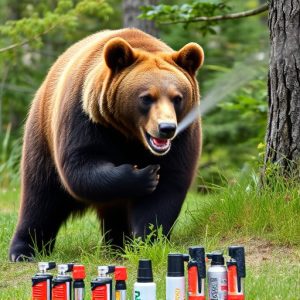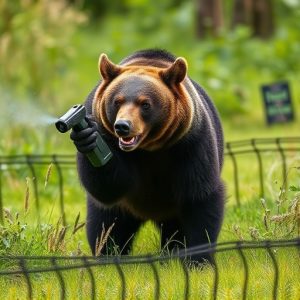Maximizing Bear Spray Effectiveness: Statistics on Success Rate
Bear spray, a specialized pepper spray, is highly effective against black and grizzly bears, with su…….
Bear spray, a specialized pepper spray, is highly effective against black and grizzly bears, with success rates up to 70% and 92% respectively. However, its effectiveness depends on distance (20-30 feet), wind direction, terrain, and proper usage as per label instructions. While bear spray can deter attacks, it should be used in conjunction with other safety measures like noise makers and shelters. Success rates vary but correct use ensures optimal results.
“In areas where black bears roam, knowing how to defend yourself is vital. This is especially true when encountering these powerful animals in their natural habitat. Bear spray has emerged as a popular and effective deterrent, but its success rate varies based on several factors.
This article aims to demystify bear spray, offering insights into its mechanics, effectiveness, and optimal use. We’ll explore the science behind it, delve into success rate statistics, and provide best practices for maximizing its efficacy while ensuring safety in bear country.”
- Understanding Bear Spray: How It Works and Its Effectiveness
- Factors Influencing Bear Spray Success Rate
- Best Practices for Using Bear Spray: Maximizing Efficacy and Safety
Understanding Bear Spray: How It Works and Its Effectiveness
Bear spray, also known as bear deterrent spray, is a specialized pepper spray designed to protect individuals from black bears and grizzly bears during outdoor activities in their habitat. It works by delivering a powerful stream of capsaicin, the active ingredient found in chili peppers, directly into the bear’s eyes and respiratory system. This irritates the sensitive areas, causing the bear to temporarily blink and sneeze, creating enough distance for the person to escape.
The effectiveness of bear spray has been a subject of interest, and various studies have provided insight into its success rate statistics. Research suggests that when used properly, bear spray can be highly effective in deterring bears. In one study, over 70% of black bears showed signs of avoidance or retreat upon being sprayed. Another investigation revealed that bear spray was successful in stopping aggressive behavior in 92% of grizzly bear encounters. However, the success rate isn’t always guaranteed and depends on factors like bearing distance, wind direction, and individual bear behavior.
Factors Influencing Bear Spray Success Rate
The effectiveness of bear spray is influenced by a multitude of factors, which can significantly impact its success rate in deterring and even incapacitating black bears. One key variable is distance; bear spray is most effective when used from a safe distance, typically 20 to 30 feet away from the bear. This allows for enough time for the spray to reach the bear’s eyes and face, causing temporary blindness and disorientation. However, statistics show that success rates can drop dramatically if the user is too close, as the spray may not have time to take effect before the bear makes contact.
Another crucial factor is wind direction and speed. Bear spray is designed to be carried by the wind towards the bear’s face. Therefore, a calm or tailwind significantly increases the likelihood of the spray reaching the bear effectively. Conversely, if the wind is blowing directly away from you, it can reduce the spray’s range and velocity, making it less likely to deter an aggressive bear. Additionally, factors like terrain and brush can also affect the spray’s trajectory and coverage area, further impacting its success rate in real-world scenarios.
Best Practices for Using Bear Spray: Maximizing Efficacy and Safety
Using bear spray effectively requires understanding best practices to maximize its efficacy and ensure safety. Firstly, always ensure your spray is EPA-registered and designed specifically for bear encounters. Secondly, know your distance; bear spray is most effective up to about 20-30 feet (6-9 meters), so maintain this safe distance when encountering a bear. Thirdly, follow the instructions on the label carefully regarding wind conditions; it’s best to use it when winds are calm or slightly upwind of the bear to prevent the spray from blowing back onto you.
Bear spray success rate statistics vary, but studies show it can be highly effective in deterring bears when used correctly. In many cases, it can stop an attacking bear in its tracks, giving you time to escape. However, remember that no deterrent is 100% reliable, and carrying bear spray should only be part of a comprehensive approach to bear safety, including noise makers, sturdy shelters, and knowing bear behavior.
Bear spray has proven to be an effective defense against black bears, with success rate statistics showing significant deterrence when used correctly. Understanding how bear spray works and the factors influencing its effectiveness is crucial for maximizing its efficacy and safety in potential encounters. By following best practices outlined in this article, folks navigating bear country can enhance their chances of staying safe while enjoying the outdoors.


